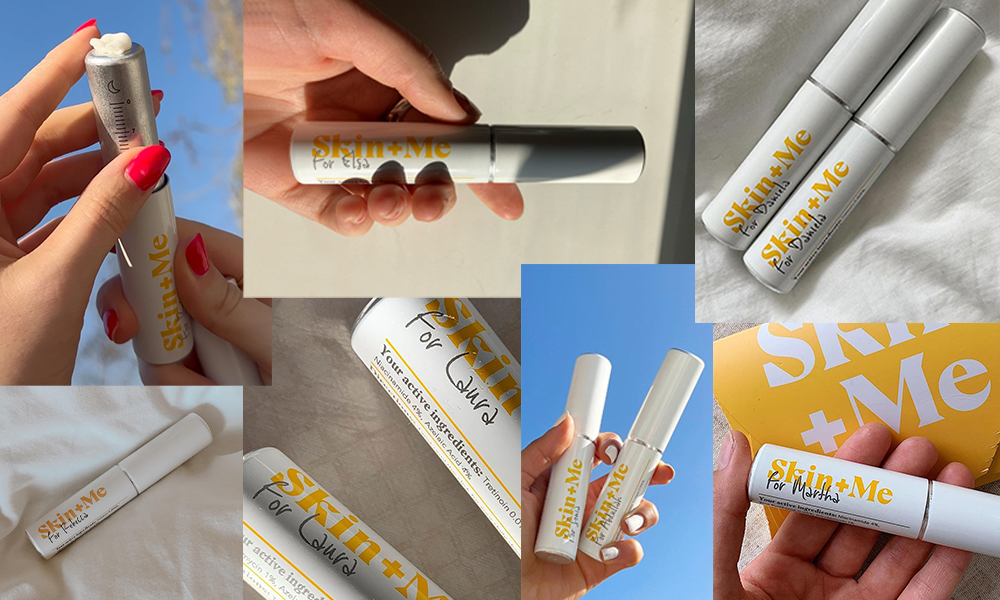Rosacea Awareness Month: Five Things to Know About Rosacea

Link to share article here:
Tretinoin And Sun Exposure
Tretinoin is a gold standard skincare ingredient, and for good reason. It’s an impressive all-rounder that can treat acne, hyperpigmentation and the early signs of ageing, while also minimising the appearance of pores and evening out skin texture.
However, it’s a pretty strong ingredient, so there are some things you need to know in order to minimise side effects and ensure the best results – and that includes being smart in the sun. Our expert Skin + Me Dermatology Team explains how to safely mix tretinoin with sunshine.
What is tretinoin?
Tretinoin is a skincare ingredient from the retinoid family, a group of synthetic and naturally-occurring compounds derived from vitamin A. It’s twenty times stronger than retinol, but in the UK it’s only available on prescription – you won’t find it on the high street.
Tretinoin was first used by dermatologists in 1962 to treat acne. However, in the 1980s doctors began to notice that patients’ spots had not only cleared up, but they also had smoother, less wrinkled skin. Since then, many studies have been conducted into tretinoin’s anti-ageing properties, along with its ability to treat hyperpigmentation.
Tretinoin’s power stems from the fact that it penetrates the skin to work on a cellular level. “Tretinoin works directly on the retinoic acid receptors found on your skin cells, making it the most powerful retinoid available,” explains Dr Ben Esdaile, Consultant Dermatologist at Skin + Me. “It works to accelerate new skin cell growth, speeding up the removal of dead cells and debris that can block pores. Tretinoin also works to repair sun-damaged cells, and boosts the production of collagen, a protein that acts like scaffolding for your skin.”
Side effects of tretinoin
Because it works on a cellular level, tretinoin isn’t a quick fix – but the results can be impressive. “Studies have shown that consistent use for at least six months is needed to see best results, and they also tell us that long-term use of tretinoin is safe,” explains Dr Ben.
Some common side effects are mild and temporary – you might experience some skin peeling, redness or break out in spots (this is known as skin purging). This is normal and can often be improved by taking a few days off from your treatment, or by buffering with moisturiser before application, although you should get in touch with your prescribing clinician if you experience any serious discomfort.
Tretinoin can also affect how your skin reacts to the sun. “Retinoids can make you more sensitive to sunlight during the first few months of use,” explains Dr Malvina, Consultant Dermatologist at Skin + Me. This is due to tretinoin bringing new skin cells to the surface, which are delicate and can be more easily damaged. So, you need to exercise some caution in the sunshine when using tretinoin, to avoid burning.
The sun can also reduce the efficacy of your tretinoin, so make sure you use it at the end of the day, not in the morning. “Retinoids are also broken down by the sun, so always incorporate them into your evening skincare routine, after cleansing,” Dr Malvina adds. For an extra layer of protection, always apply sunscreen in the mornings after using tretinoin.
Using tretinoin in the summer
You might think that, because tretinoin can heighten sensitivity to the sun, it’s best to avoid using it altogether during the warmer months. However, consistency is key for achieving your skin goals – so, as long as you’re protecting your skin from the sun, it’s absolutely fine to use tretinoin during the summer.
“You should wear a broad-spectrum sunscreen so that you’re protected against both UVA and UVB rays, with a SPF of at least factor 30,” says Dr Malvina. “The purpose of SPF is to protect our skin from harmful UV radiation that are the main cause of sunburn, skin ageing, hyperpigmentation and skin cancer.”
“UV rays can penetrate through windows, and wearing SPF daily reduces both outdoor as well as indoor exposure,” Dr Malvina continues. “Using sunscreen every day can also slow down the ageing process, reduce problems with pigmentation and visibly reverse the signs of photo damage.”
Our Skin + Me Daily Defence Oil-free SPF 50 Sunscreen is a great option for all skin types and tones – it dries down clear and doubles up as a primer under makeup. It’s also fortified with niacinamide and vitamin E, to regulate oil production and strengthen your skin barrier.
Don’t forget to reapply your sunscreen regularly, especially if you’ve been swimming or sweating. Remember to also minimise your time spent in very strong sunlight, especially between 11am and 3pm, and wear a hat and sunglasses to protect your eyes and face.
The bottom line
From acne to fine lines, tretinoin can treat an impressive list of skin concerns – however, it can also increase your sensitivity to sunlight. So, if you’re using retinoids, make sure you’re also using sunscreen with at least SPF 30 to protect your skin from the harmful effects of UV rays. The best sunscreen is the sunscreen you’ll wear every day, so pick one you love and make it part of your morning routine.
New to Skin + Me? Get your first month of personalised skincare for £4.99 with promo code DOSE – complete our quick consultation here.
Looking for a routine refresh? Add the Dream Routine to your Skin + Me subscription.
In need of a restock? Head to The Skincare Shop for one-off purchases of your Routine Essentials.



